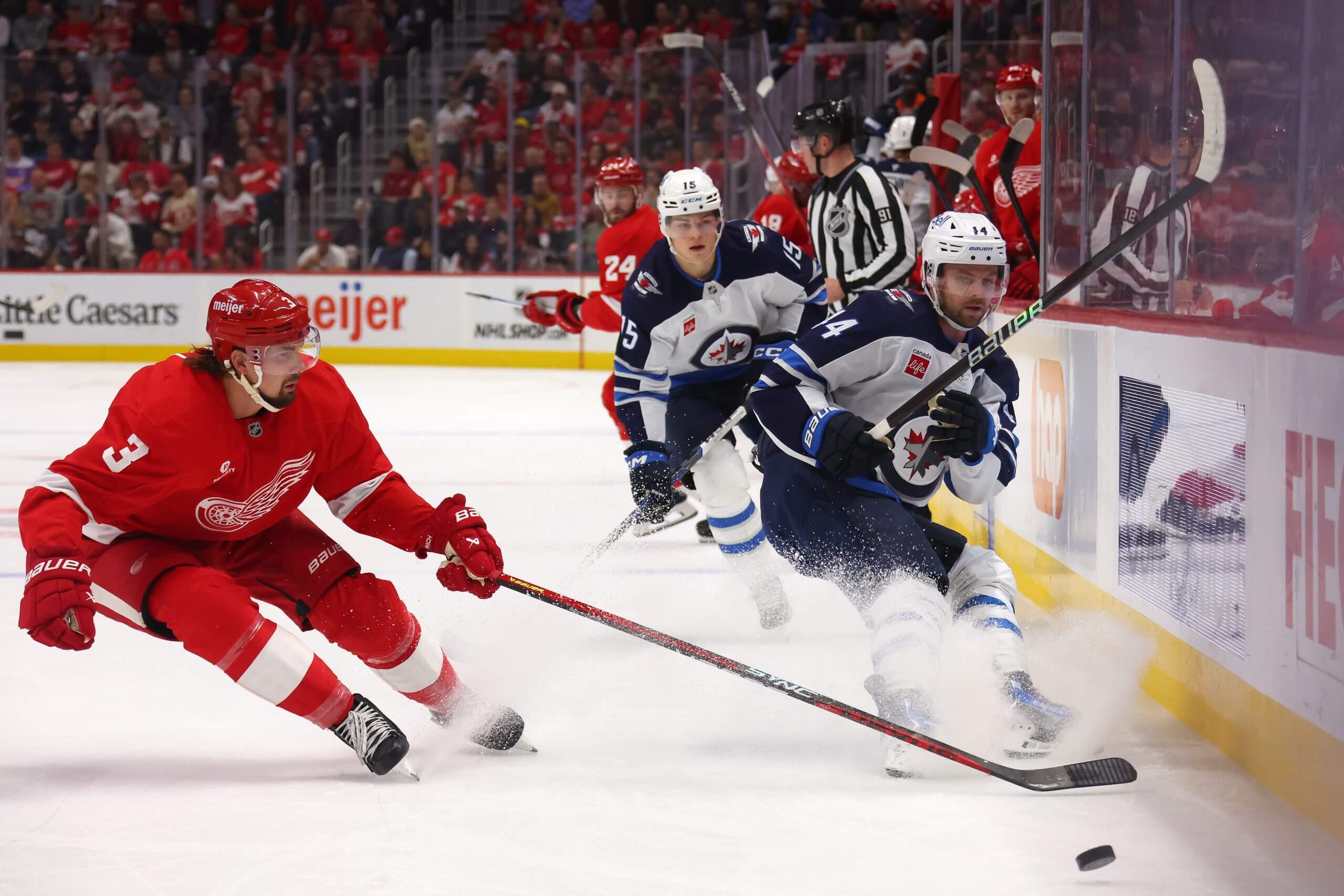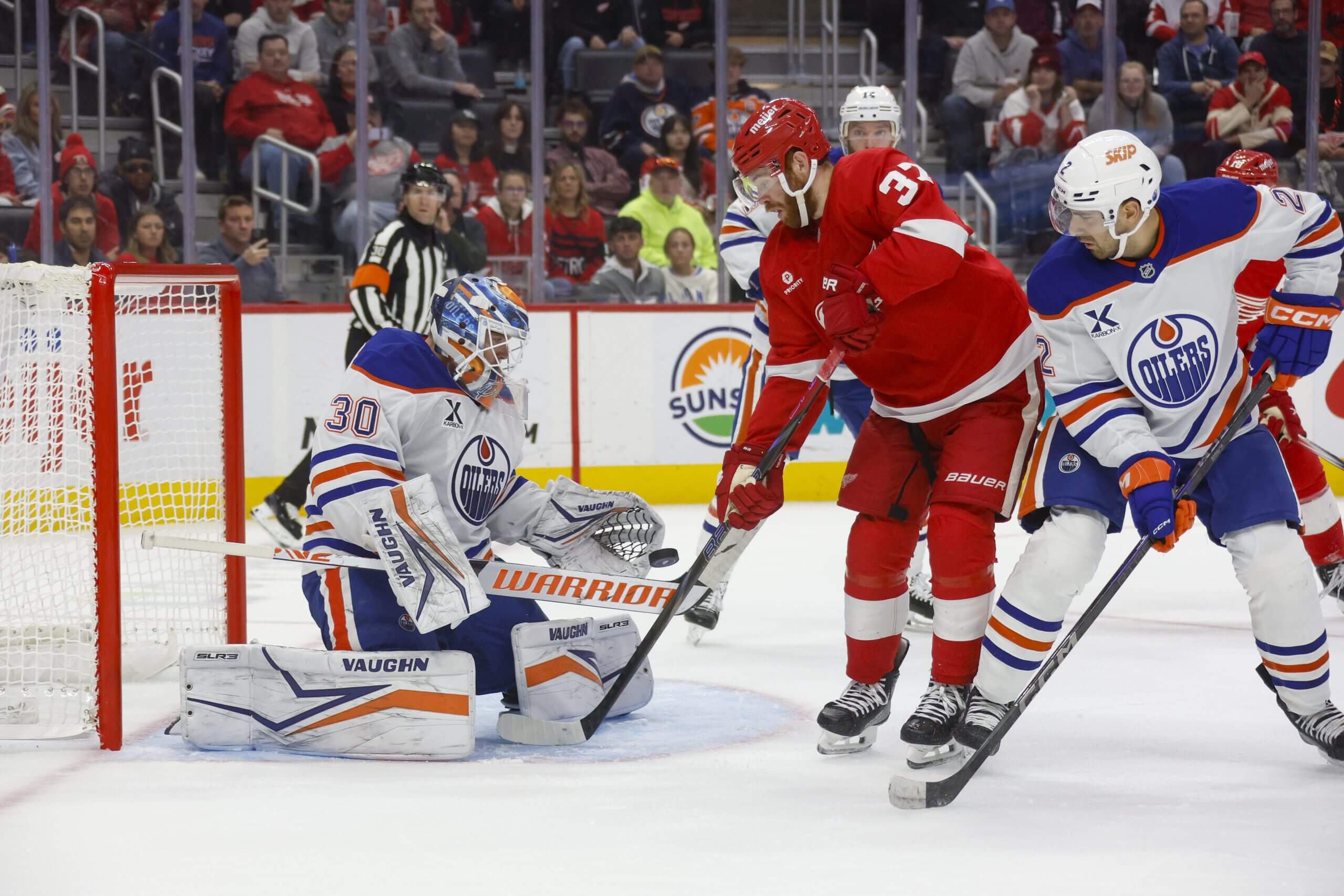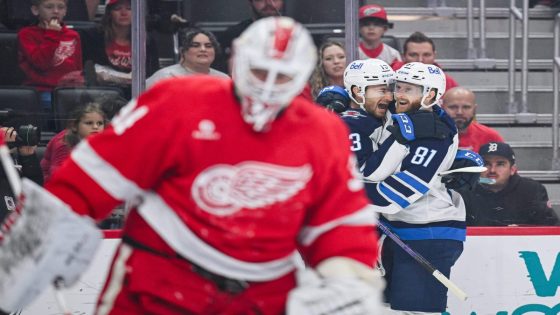DETROIT — It was another frustrating night Wednesday at Little Caesars Arena — a sentiment that’s been all too common 10 games into the season.
Boos rained down from the stands after a first period that saw the Detroit Red Wings give the Winnipeg Jets an early 3-0 lead. And even after Detroit fought back with a pair of goals to cut it to 3-2 after two periods, any momentum vanished just 10 seconds into the third when Jeff Petry misplayed a rimmed puck, leading to a turnover and a puck that banked off Ben Chiarot’s skate and into Detroit’s net.
“That was a killer,” Dylan Larkin said.
It was a bad bounce, to be sure. But after a 6-2 final score left them with a 4-5-1 start 10 games into the season, the Red Wings’ early problems have run much deeper than puck luck. That record puts them in a four-way tie for fifth in the Atlantic Division. You could also call it a four-way tie for last.
So, how did Detroit get here? And what will it take to get out of it? Here are 10 thoughts after Detroit’s first 10 games.
1. The Red Wings continue to get outshot on a consistent basis, so it likely won’t shock you to learn that as of the end of their game Wednesday, they were giving up the league’s third-most shots on goal per game at 34.3 — and generating the fewest shots per game at just 24.4. That’s a hard way to live in the NHL.
That stat is a symptom, though. It’s obviously not Detroit’s plan to get outshot by double digits. It’s a product of the things they aren’t doing well enough on a nightly basis.
Hockey is such a fluid sport that isolating a single problem is hard, but two glaring things jump out when watching the Red Wings: struggles with breaking out of the defensive zone and an inability to generate sustained time in the offensive zone.
2. Those two issues are connected — it’s hard to have offensive zone time if you can’t get out of your end — but distinct.
Detroit has done relatively well for most of this season at keeping shots to the outside. It’s middle-of-the-pack when it comes to giving up high-danger chances. That’s the good news. But clearing the zone has consistently been a problem — whether it’s failed clears up the walls leading to long shifts stuck defending or flips to the middle of the ice, where opponents can easily regroup and re-enter.
All that time spent defending takes a toll, and sometimes that means when the Red Wings do get an exit with possession, the only real option is to dump and change to get fresh legs on the ice. It’s a vicious cycle, and as a result it’s not too surprising the Red Wings entered Wednesday night below the league average of 40.8% time spent in the offensive zone at 37.6%.
The NHL does not publish full rankings or percentiles for NHL EDGE data below the 50th percentile, but Detroit’s 37.6% figure is below the Philadelphia Flyers, Montreal Canadiens, San Jose Sharks and Columbus Blue Jackets so far this season.

3. Coach Derek Lalonde was asked Wednesday what he hoped the team’s identity was, and he pointed to the “flashes” the team has shown so far: the strong first period Sunday against Edmonton and the second period Wednesday.
“Getting out of our zone, we’re getting through the neutral zone, we’re getting behind them, and we’re getting a little sustained O-zone (time), some momentum,” Lalonde said.
Getting out of the zone is the first step to all of that, to be sure, but it’s not as though Detroit has consistently shown it can complete the rest of the checklist.
“It’s tough to get things off the rush,” Lalonde continued. “And we have guys that want to get it off the rush. If it’s there, we’ll take it off the rush — like early in the first, we had a couple plays on the rush, obviously (Andrew Copp) in all alone a couple times there. You’re going to get that when it’s given. But it’s the other — the grind stuff — we just need more.”
And that is true. The biggest reason for success in that first period against Edmonton was Detroit winning pucks down low and manufacturing offense. That’s how J.T. Compher scored to begin that game: a battle won by Copp and then a nice feed to the slot from Patrick Kane, who was down there supporting him off the battle. Then later, that line scored again by getting traffic to the net, with Copp redirecting a point shot.
4. To me, that starts with having more of a presence on the forecheck, but Lalonde extrapolated beyond that.
“It doesn’t necessarily have to be a forecheck, it’s just take what’s given,” he said. “We do that sometimes, but — obviously we’ve got to get a forecheck, but forechecks, a lot of it is puck placement, it’s all five guys involved. There’s just a couple times we missed opportunities where they just had a little short breakout or a little puck support, we just weren’t on top of it. We’re a step slow with our forecheck and being on top of them in O-zone.”
5. Some of this, of course, falls to Lalonde to correct as the coach of the team. That’s his domain. But the composition of the roster is inescapable in all of this, too. The Red Wings’ skilled forwards are mostly on the smaller side, not as suited to winning pucks on the forecheck or wreaking havoc around the net. Meanwhile, their natural forecheckers lower in the lineup can at times struggle to maintain possession.
It’s a problem they can try to solve with different line combinations, and they’ve tried plenty already (I liked the ones they rolled against Edmonton), but at a certain point, the makeup of the roster just doesn’t leave many easy answers.
6. That all said, I do think the Red Wings can be better than they’ve been — and that’s up and down the lineup.
This Detroit team isn’t as deep as last year’s, so it’s going to rely even more on those top-of-the-lineup players to carry the offense, and while they’ve been OK so far, the construction of the team means they’ll need to deliver even more.
I’ve thought Lucas Raymond has been their best player, producing at a point-per-game pace, and I think he’s a bit banged up after an awkward spill into the boards against the Oilers. But Detroit will still need him to shoot a lot more than the four shots on goal over his last five games. Larkin and Alex DeBrincat have five goals apiece after both scoring Wednesday. But Larkin has another level of playmaking that he hasn’t tapped into as much this year, and DeBrincat, even for all his early goals, has left a few more out there, too.
The team’s second line, no matter who’s next to Compher and Kane, has to be a consistent scoring threat. And the bottom six has to be able to use some of those heavier bodies to at least wear down opponents on the forecheck and with O-zone pressure. Really, that’s the best way to defend.

7. On defense, you expect some learning curve still from the young pairing of Simon Edvinsson and Moritz Seider, but when they’re taking the tough matchups they do, there isn’t much margin for error. They’ve been one of the bright spots on the team so far, especially in the big picture, and that shouldn’t be lost in all this. In the role they’re playing, though, the expectations — and degree of difficulty — are quite high.
Meanwhile, on the earlier note about failed clearing attempts, Chiarot and Petry have been fairly frequent culprits when hemmed into the defensive end. And offseason addition Erik Gustafsson, who was a scratch Wednesday, will need to give the Red Wings’ power play much more of a spark than he has.
These are players Detroit really leans on, and while the problems are certainly not theirs alone, all have more to give than what they’ve shown.
8. I asked Larkin what the team’s biggest challenges have been through the first 10 games, and here’s what he said:
“I think obviously we haven’t been very good on the special teams, winning the battles. Our goaltending’s been good, that’s been a highlight. And we haven’t scored enough five-on-five. We haven’t been hard enough — you’ve seen glimpses of it — (but) we haven’t been hard enough around the other team’s goalies. In my opinion, it’s all fixable. And I think we have the personnel to do it. But we were in a similar position last year: We need to figure out what we are as a team and start to gain some traction and play to an identity.”
9. Those issues Larkin cited may indeed be fixable, even with a roster that leaves something to be desired, if the players can really buy into doing so. Getting more traffic to the net, being harder in those areas and performing better on the penalty kill — which has been particularly bad — are all achievable for this group.
But it is going to take a concerted effort. And while it’s still just October, 10 games represents a big enough sample to know those issues are real.
10. There’s a lot of season left and time for this team to find that identity to which Larkin alluded.
Last year’s team, to his point, was a streaky group, and by mid-November there were plenty of alarm bells before it won six out of seven. A quiet stretch followed that, but then another strong run in the new year. It went like that the whole way, basically, down to the wire — ultimately missing the playoffs on a tiebreaker.
The concerning thing right now, though, is this team hasn’t resembled last year’s group. It’s looked like a clear step back.
Again, it’s early, and it’s too soon to panic.
But even with 72 games remaining, it’s clear the Red Wings have their work cut out for them to get back on track.
(Top photo: Tim Fuller / Imagn Images)





